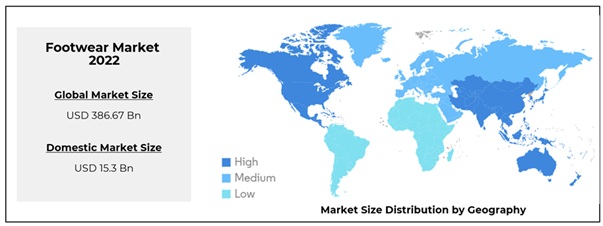The footwear industry is experiencing a dynamic transformation worldwide, driven by shifting consumer preferences, technological innovations, and rising environmental consciousness. India, already a global leader in leather footwear manufacturing (2nd largest manufacturer and consumer of footwear), is fast emerging as a powerhouse in the non-leather footwear segment. With the government's focused policy support, increasing investments, and an evolving industrial ecosystem, the non-leather footwear sector is poised to be a major contributor to India's manufacturing ambition, making the country a definitive player in the global footwear landscape.
India's Footprint in the Non-Leather Footwear Market
India stands as the 2nd largest producer and consumer of footwear globally[1], spanning both leather and non-leather. Over the past decade, non-leather footwear has witnessed a phenomenal growth both globally and domestically. This upward trajectory reflects growing demand for sustainable alternatives and expanding domestic market consumption fuelled by a youthful demographic (371 Mn youth (15–29 years, 27% of the population[2]), has the world's largest youth demographic) and increasingly affluent population (rapid urbanisation: projected to exceed 40% by 2036 with nearly 600 Mn urban residents by 2030[3]).
The state of Tamil Nadu leads the charge as the India's non-leather footwear hub, home to a broad ecosystem of MSMEs, manufacturing clusters, and big industrial houses enabling scale and innovation. The state's prowess is complemented by emerging clusters in Uttar Pradesh, Bihar, and other regions, creating a geographically diversified production base[5]. Employing over four and a half million people[6], the sector is notably a major source of employment, providing socioeconomic upliftment in rural and semi urban areas.
Tamil Nadu's evolution as a non-leather footwear hub[7], driven by progressive sector specific policies and robust government initiatives and support, exemplifies India's potential to attract global investments and harness domestic expertise. Taiwanese and Vietnamese firms have established large scale manufacturing facilities in the state, producing high quality products for leading international brands such as Nike, Puma, Adidas, and Crocs.
Non-leather footwear is reshaping domestic and global markets. In India, it's projected to grow from 25% to 75% of the $90B market by 2030[8], driven by young, urban, style-conscious consumers. Globally, it anchors the shift toward sustainability, with the market set to reach $13B by 2030 and vegan footwear doubling to $72B by 2035[9].
By 2030, India is projected to be the only country in the world to witness an incremental growth of at least 500 Mn pairs over its current footwear production of approximately 2 Bn pairs[10], spanning both domestic consumption and exports. This unique trajectory underscores India's pivotal role as the fastest-growing hub for global footwear demand and supply.
The environmental advantages are substantial as well: non-leather footwear production reduces water consumption, eliminates harmful chemicals like formaldehyde and mineral salts used in leather tanning, and utilises sustainable materials such as recycled plastics, organic cotton, and plant-based alternatives. This aligns with global supply chain diversification trends, where brands are seeking resilient, sustainable manufacturing partners to meet stringent ESG requirements and regulatory compliance, particularly as legislation like the EU's Corporate Sustainability Due Diligence Directive reshapes industry standards.
Government Initiatives: Catalysing Growth and Competitiveness
The Indian government strongly emphasises on accelerating the growth of the non-leather footwear sector through a range schemes and policy measures. Recent Union Budget announcements have focused on boosting machinery procurement, design innovation[12], and availability of critical inputs for non-leather footwear production. Notably, the complete exemption from Basic Customs Duty on vital raw materials like Wet Blue Leather[13] has strengthened domestic value addition and enhanced export competitiveness. Targeted reforms aimed at simplifying labour laws, reducing compliances, and facilitating foreign direct investment continue to create a favourable business environment.
Recent Trade Agreements have further bolstered India’s non-leather footwear sector by enhancing market access and reducing tariff barriers. India’s expanding network of bilateral and multilateral trade deals with key partners such as the United Kingdom[14], United Arab Emirates[15], Australia[16], and the European Union[17] is enabling exporters to compete more effectively in global markets. These agreements facilitate smoother supply chains, better regulatory cooperation, and provide the sector with a strategic advantage. By leveraging these trade deals, India’s non-leather footwear manufacturers are positioned to increase exports, attract foreign investment, and integrate more deeply into global value chains.
Significantly, the upcoming National Leather and Footwear Policy[18] is expected to be a game changer. This new policy framework is anticipated to provide a comprehensive, long-term vision for the sector by promoting advanced infrastructure development, technology adoption, sustainability, and global competitiveness. Its implementation is set to propel India’s non-leather footwear industry onto a higher growth trajectory, aligning with the country’s ambitions of becoming a global manufacturing and export hub.
Challenges and Strategic Imperatives
India’s non-leather footwear industry has achieved notable progress, supported by strong government initiatives and industry efforts. At the same time, external challenges such as high import tariffs in key destinations, including the United States, create headwinds for exporters. Recent tariff hikes where Indian footwear faces duties significantly higher than competitors underscore the importance of ongoing trade negotiations and Free Trade Agreements being pursued by the Government of India to secure a level playing field for domestic manufacturers.
Recognising the need to strengthen competitiveness, the government has prioritised investments in technology upgradation, workforce skilling, and infrastructure. Initiatives through institutions such as NIFT[19], FDDI[20], and CFTI are already enhancing design, material innovation, and training capacities, though the scale of industry demand calls for further expansion of these programs.
India is also taking steps to address structural challenges. While the sector currently relies on imported inputs such as synthetic materials, adhesives, and components[21], efforts are underway to build domestic manufacturing ecosystems, reduce supply chain vulnerabilities, and lower cost dependencies. Parallelly, schemes to support MSMEs[22], modernise production facilities, and encourage cluster-based development are helping smaller manufacturers adopt modern technologies and expand their global footprint.
These measures position India strongly to move up the value chain, capture premium market segments, and reinforce its role as a reliable and competitive supplier in global non-leather footwear trade.
The Road Ahead: From Make in India to Make for the World
Unlocking the true potential of India’s non-leather footwear segment demands a concerted and holistic approach. The sector’s ability to generate millions of jobs, empower women, and contribute to regional development aligns seamlessly with India’s broader economic and social objectives.
Government programs will continue to nurture an investor friendly ecosystem, enhance financial support for R&D, and incentivise sustainability driven production. Industry players must also embrace innovation, leverage India’s demographic dividend, and build export capabilities grounded in quality and cost effectiveness.
As global manufacturers diversify their supply chains away from China, India’s non-leather footwear industry is poised to emerge as the preferred manufacturing hub. With the combined momentum of policy reforms, industrial excellence, and global demand trends, India can transform this sector into a driving force for economic growth, moving confidently from ‘Make in India’ to ‘'Make for the World.'
Authors:
Mr. Maanvik Raj Singh – Associate – Leather & Footwear Team | Invest India
Mr. Vikas Bajargyan – General Manager | Ortholite India



